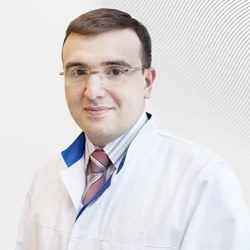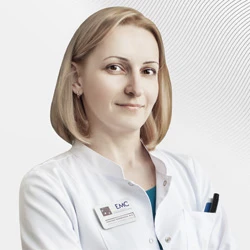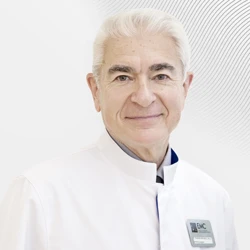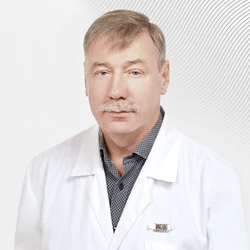In addition to aesthetic discomfort, obese patients are usually accompanied by somatic problems: hypertension, joint disease, type 2 diabetes, infertility, etc. Recent studies prove that patients with pathological or morbid obesity are much more likely to develop oncological diseases, in particular melanoma. Life expectancy is reduced by an average of 10-12 years. To help patients with obesity, the EMC has created a comprehensive program with the participation of nutritionists, endocrinologists, bariatric surgeons, internists, gastroenterologists, and psychologists.
In what cases is the operation performed?
To date, the most effective treatment for pathological obesity is surgery. We operate on patients with a body mass index (BMI) greater than 35 kg/m2. BMI is calculated as body weight in kilograms divided by height in square meters. For example, for a man with a height of 180 cm and a weight of 130 kg, the BMI will be 40 kg/m2. The only limitation for performing bariatric surgery is age. According to the legislation, it is forbidden to operate on patients under the age of 18. Although adolescent bariatrics exists and is actively developing in many countries. There is such a need in Russia as well: According to international estimates, we are ranked 7th in terms of obesity in the world.
What methods of surgical treatment of obesity are used in EMC?
We use three techniques.
Installation of an intragastric balloon
This auxiliary technique is used as part of the comprehensive treatment of obesity. A balloon with a volume of up to 650 ml is installed in the stomach, which causes a feeling of satiety. In fact, this is not an operation, but an endoscopic procedure, which is performed by experienced endoscopists at the EMC. The balloon is filled with saline solution, colored blue. Staining helps to diagnose a balloon breakout in time. The fact is that patients with a lot of weight can crush it when they lie down on their stomach. If the urine turns blue, it means that the balloon is damaged. In this case, you need to urgently consult a doctor to rule out intestinal obstruction. The cylinder has a service life of 6 months, after which it must be removed during endoscopy.
The balloon is a temporary measure. While it is in the stomach, the person loses weight and feels comfortable, as soon as the balloon is removed, the feeling of hunger returns, and the patient gains weight again. We use balloons only as preoperative preparation for "heavyweights" – patients with a body mass index of 60 kg/m2 and more. They are installed so that the patient can lose some weight and undergo the main bariatric surgery more easily.
Laparoscopic longitudinal gastric resection
Currently, the most popular surgical method of weight loss. In addition, it is also the most physiological. Laparoscopic longitudinal gastric resection is recommended for patients with grade II-III obesity (BMI 35 kg/m2 and above). During the operation, the surgeon reduces the volume of the stomach by 5-6 times and removes the area responsible for the production of the "hunger hormone" – ghrelin. The physiology of the operation lies in the fact that the antireflux mechanism of the esophagocardial junction, i.e. the passage of the esophagus into the stomach, is preserved, as well as the pyloric mechanism that regulates the flow of food from the stomach into the duodenum. Due to this, "operated stomach syndromes" do not occur after surgery: dumping syndrome and reflux gastritis, which dramatically reduce the patient's quality of life. We do not interfere with the natural digestive process, but only remove the excess of the stretched stomach wall and the zone of production of the "hunger hormone".
In addition, after surgery, the duodenal passage of food is preserved, which continues to flow through the duodenum, which is a powerful reflexogenic zone: it regulates the process of bile secretion, affects the functioning of the pancreas and the motility of the small intestine. Laparoscopic technique ensures minimal injury to surrounding tissues, rapid recovery and a good cosmetic effect.
Biliopancreatic bypass surgery (BPS)
For the treatment of "heavyweights" (BMI greater than 60 kg / m2), we use a more complex operation - biliopancreatic bypass surgery (BPS), which reduces not only the volume of the stomach and removes the "hunger zone", but also develops malabsorption syndrome, i.e. decreases the ability of the small intestine for suction. As a result, food and digestive juices move through the gastrointestinal tract separately and meet in the small intestine about 75 cm before it passes into the large intestine. Thus, only this area of the small intestine is involved in the absorption of nutrients. BPS significantly changes the physiology of digestion, but at the same time it allows you to reduce weight in "heavyweights" who, after surgery, get rid of most of the life-threatening conditions associated with grade III-IV obesity.
In some cases, we carry out step-by–step treatment of "heavyweights": the first stage is laparoscopic longitudinal resection of the stomach, and after a year and a half, after a significant weight loss by the patient, bypass surgery in safer conditions.
Removal of adjustable bandages
There is another type of surgery – removal of adjustable bandages previously installed in other clinics. The installation of a bandage for the treatment of obesity was widely used some time ago. The long-term presence of the bandage quite often leads to the development of complications in the form of scarring, stenosis and germination of the bandage through the stomach wall. Therefore, we have to remove bandages quite often, and to prevent patients from gaining weight after that, laparoscopic longitudinal resection of the stomach must be performed.
Overweight patients need early activation to prevent metabolic and pulmonary complications. Our patients get up and walk on the day of surgery. As a rule, they are discharged from the hospital on the 3rd day. But we don't say goodbye to the patient forever, we hand him over to a team of endocrinologists, nutritionists, gastroenterologists and psychologists who develop an individual comprehensive support program. If necessary, we can involve a doctor of any specialization. We often perform surgeries on the recommendation of related specialists, such as orthopedic traumatologists, when a patient needs to reduce weight before undergoing knee and hip replacement surgery in order to avoid early complications and speed up the recovery process.
For many patients, it is psychologically difficult to come to a consultation with a nutritionist or a bariatric surgeon. It is important to understand that excess weight is not only an aesthetic problem, it is a complex of concomitant diseases, the need to exhaust yourself with diets, and take sugar–reducing medications. The shorter the experience of type 2 diabetes, the more likely it is that after bariatric surgery, sugar levels will return to normal and the need for therapy will disappear. Quite often, we operate on patients with diabetic foot syndrome, when there is a risk of limb loss due to diabetes mellitus and purulent complications. Therefore, you should not be afraid to take the first step and trust the specialists.
Gastric surgery has always been every surgeon's dream. This is one of the peaks of surgical skill. The operation itself is not technically difficult, but there is a possibility of developing intraoperative problems that the surgeon must cope with. Bariatric surgery should be performed by an experienced surgeon in a well-equipped operating room with adequate anesthetic equipment. Naturally, we need a team of doctors who will guide the patient further. This complex allows us to effectively and quickly solve the problems of excess weight.





.webp)







.webp)

.webp)
.webp)





.webp)


